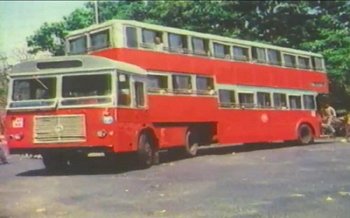Double decker buses ready to make a comeback in Bengaluru ?
Mangalore Today News Network
Mangaluru, May 25, 2017: In Bengaluru in the 1990s you may remember riding the double-decker buses, with everyone rushing to grab the best seats on the top front deck. The double-decker buses might make a comeback to the city it is said.
 With the central government publishing specifications for double-decker buses, Bengaluru Metropolitan Transport Corporation (BMTC) is expected to buy four or five vehicles by the end of the year it is reported.
With the central government publishing specifications for double-decker buses, Bengaluru Metropolitan Transport Corporation (BMTC) is expected to buy four or five vehicles by the end of the year it is reported.
According to BMTC Managing Director, Ekroop Kaur, the BMTC had not bought double-decker buses till now as there were no specifications laid down by the centre for such buses.
“We may buy four or five double-decker buses by the end of 2017,” he told media.
Kaur said that in April 2016, the Automotive Research Association of India, the certified organisation to fix specifications in India, had come up with specifications for double-decker buses.
These buses were extremely common in Bengaluru from the 1970s to the late 1990s.
Double-deckers plied on different routes including Indiranagar to Kempegowda Bus Station, Shivajinnagar to KR Market, Kempegowda Bus Station to Jayanagar 4th Block, Gandhi Bazaar to Majestic and Jayanagar to Shivajinagar.
In the 1980s, a double-decker bus carrying schoolchildren turned turtle near Ramakrishna Mission, near Gandhi Bazaar. This was the turning point for the double-decker buses. The BMTC, which was then called the Bangalore Transport Service, gradually began taking off these buses from Bengaluru’s streets, and by 1997 there was not a single double-decker in sight.
BMTC retained one double-decker bus, which was being used as a city tour bus till 2014. The Bengaluru Darshan bus takes tourists sightseeing around the Bull Temple, ISKCON Temple, Gavi Gangadeshwara Temple, MG Road, Tipu Fort, Ulsoor Lake and Vidhana Soudha.
BMTC has not yet decided whether double-deckers will be deployed for general services or if they would be restricted to tourism purposes.
Kaur said that the narrow roads, overhead cables and canopies will disturb the movement of double-decker buses. The traffic density in the city is not feasible for a slow, large bus to ply on its streets any more.
Canopies on the roads will obstruct the buses. Secondly, only some roads are wide enough for them to turn as their turning radius is more than that of ordinary buses. The routes in which these buses will ply have not yet been identified. So, let’s wait and watch?
- Mangaluru: Police invoke KCOCA against three, including rowdy-sheeter
- Mangalore University admit misusing Rs 7 crore RUSA funds
- From depression to glory: Jemimah Rodrigues faith-fuelled journey to World Cup triumph
- Kundapura: Rs 2 lakh cash stolen after breaking car window
- Mangaluru: Black panther spotted near Nelliteertha temple
- Car gutted in fire on Madikeri–Mangaluru road
- Sullia: Three sentenced in benefit scheme fraud case
- Mangaluru: MP Brijesh Chowta urges Centre to expedite ESIC takeover of ESI hospital
- Mangaluru: ADC Raju K orders closure of shops selling loose cigarettes, allowing public smoking
- Mangaluru: Police save man and daughter who tried to end lives after domestic dispute
- Mangaluru: Fake Facebook account created in name of City Police Commissioner
- Environmentalist Nagaraj Bajal completes 300-km solo walk to spread awareness on waste management
- Udupi: Fake website dupes devotees booking Kollur Temple rooms; case registered
- Rahul Gandhi exposes major vote theft in 2024 Haryana polls; claims ECI in cahoots with BJP
- Rs 70 crore fraud at EPFO credit society, 2 arrested from Bengaluru
- 103 ancient gold coins found during Tamil Nadu temple renovation
- Bidar: Three killed as car collides head-on with courier vehicle
- Indian-origin Democrat Zohran Mamdani wins New York mayoral contest
- Death toll rises to 11 after passenger train collides with goods train in Chhattisgarh
- Bengaluru: Police arrest 10 for submitting currency notes with tampered serial numbers to RBI
- 4 terrorists hiding in village shot dead in Army’s dawn operation in Manipur
- Not allowed to feel safe: Mumbai woman harassed by taxi drivers in Kerala
- Inside Canada’s mass visa cancellation plan that may target Indians
- Bengaluru: Customs seize Rs 37.88 crore worth drugs at Kempegowda Airport
- Travellers could soon get option to refund, reschedule, cancel flight tickets
- APD Foundation Joins WHO Civil Society Commission
- Daiva’s prediction comes true: Janardhan Reddy walks free from jail
- Skills and Competencies Take Center Stage at MSN Dialogue Series
- Court remands Maoist Lakshmi to six-day police custody
- Sandhya Shenoy honored with Society for Materials Chemistry Medal-2024
- White Cornus Apartment in Mangaluru
- City girl wins first place in state-level spell bee competition
- Alleged ‘Love Jihad’ Case in Mangaluru: Woman left home voluntarily, says police
- Girl fatally struck by reckless two-wheeler near Belman
- New residential complex for the judges inaugurated in Mangaluru
- Absconding accused nabbed after 8 years
- Truck with cylinders turns turtle in Beltangady
- Bhoota Kola artist dies of cardiac arrest
- Development of the country should be our goal: Ganesh Karnik
- Container truck gets stuck under Modankap railway bridge
- CITY INFORMATION
- TRAVEL
- TOURIST INFORMATION
- HEALTH CARE
- MISCELLANEOUS




 Write Comment
Write Comment E-Mail To a Friend
E-Mail To a Friend Facebook
Facebook Twitter
Twitter  Print
Print 

